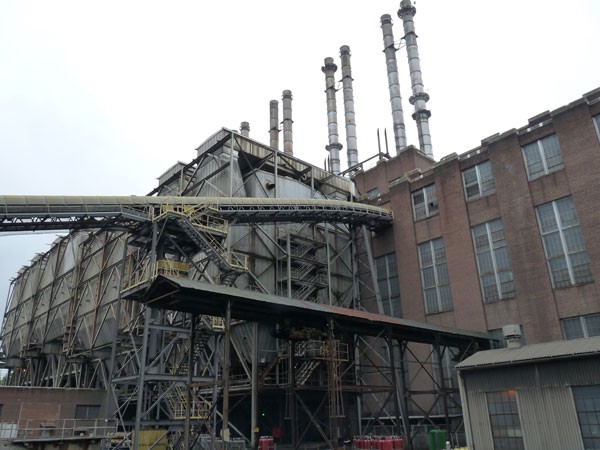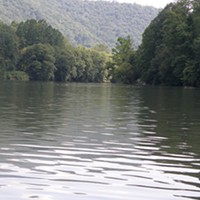Fishing and swimming in the Dan River were a huge part of Ben Adkins' youth; he hoped to share those experiences with his young children. "It's where I spent my summers my whole life. It's where I first experienced God and knew he was real," Adkins, 37, says. But now, he says, he wouldn't let his dog drink from the river.
While most of us were watching this year's Super Bowl, a waste pond at Duke Energy's coal plant in Eden, N.C., began vomiting enough coal ash into the Dan River to turn it steel-gray, contaminating it for at least 70 miles and who-knows-how-many years.
As Duke struggled for more than a month to stop several leaks into the Dan River, the coal industry's vague assertions about coal waste being no big deal have crumbled. The Eden spill became the third largest coal ash spill in United States' history, sparking a federal investigation into Duke's relationship with North Carolina regulators. Now, people across the nation are tuning in to a critical water-quality concern: Waste ponds full of heavy metals and radioactive elements are draining and leaking into our drinking water.
This week, shareholders are in town for the company's annual shareholder meeting, and powerful voices in that group are demanding answers about the company's coal-ash management practices. Perhaps these influential shareholders can return Duke Energy to good-neighbor status by doing what's right: Moving coal ash away from our drinking water.
GROUND ZERO FOR COAL ASH

- Rhiannon Fionn
-
According to the Catawba Riverkeeper, Duke's Riverbend Steam Station on Mountain Island Lake has 71 acres of coal ash ponds.
Duke Energy's Riverbend plant is located a dozen miles from Uptown, barely over the Gaston County line in Mount Holly. It's close enough that you can see "Voltron," the company's colorfully lit headquarters, from the edge of the property. The plant closed in 2013 after 84 years in operation, but its coal ash ponds remain on the edge of Charlotte's main drinking water reservoir, Mountain Island Lake. The ponds are unlined, larger than the one that damaged the Dan River, and constantly draining and leaking pollutants like arsenic trioxide into our city's drinking water.
Sam Perkins works for the Catawba Riverkeeper Foundation, a nonprofit that advocates to protect the river. Perkins compares Riverbend's coal ash ponds to tea bags, only the contaminant-laden waste steeps in groundwater that ebbs and flows with nearby surface water — the same water we drink from and bathe in after treatment by the Charlotte-Mecklenburg Utilities Department (CMUD).
Charlotte-Mecklenburg officials say the water's fine, as do those treating water from the Dan River. That's somewhat comforting, but officials don't test for everything found in coal ash. A study conducted by geochemistry professor Avner Vengosh of Duke University concluded that trace amounts of both arsenic trioxide and strontium — which is radioactive — were found in Mountain Island Lake. The EPA confirmed those things are linked to coal ash. CMUD doesn't test for strontium.
There are no federal regulations for coal ash, and few in any state; North Carolina has more than most, though companies are mostly left to self-monitor. After a massive coal ash disaster in Tennessee in 2008, the EPA promised regulations by the end of the following year. Instead, it issued two regulatory options and held an eight-city public hearing tour, collecting about 500,000 public comments. Vengosh testified at the 13-hour hearing in Charlotte in September 2010: "The impact of [coal ash] on water resources, however, is not restricted to a single accident, as over 500 power plants nationwide generate approximately 130 million tons of [coal ash] each year. Only in North Carolina, about a billion gallons of effluent coming from holding ponds is discharged into the environment. This is equivalent to the amount of drinking water in New York City for 8 million people every day."
Alice Battle, who passed away in February, was the Mountain Island Lakekeeper and a Mountain Island Lake Marine Commissioner for seven years. She testified at the EPA hearing that both the Catawba Riverkeeper Foundation and Mecklenburg County "found excessive amounts of arsenic in the samples near the discharge from the ash ponds" at Riverbend, that the sediment in the lake is particularly responsive to arsenic and that "the current in the river is quite strong at times, so the sediment is moved downstream."
WORST-CASE SCENARIO

- J. Wes Bobbit, flight courtesy of SouthWings
The discharge from Riverbend's plant is three miles upstream from the Catawba River pumping station, where Charlotteans have been pumping public water out of the river since the 1800s. It's where approximately 80 percent of our city's drinking water comes from still, nourishing nearly a million people and making thousands of businesses possible.
Should there be a major coal ash spill at the Riverbend plant, Mecklenburg County's water quality program manager Rusty Rozzelle once told CL, "It would be the biggest catastrophe Charlotte's ever seen."
However, thanks to nebulous terrorist threats, the city's emergency plan isn't public knowledge. Meanwhile, smaller cities such as Danville, Va., which is 20 miles downstream from the Dan River coal ash spill, have disclosed their plans.
The EPA's 2009 assessment report for Riverbend indicated that the earthen dams are structurally sound, but let's entertain the worst-case scenario: Unlike the Dan River, which is free-flowing, a major concern for Charlotte is the Mountain Island Dam, which Duke Energy built in the 1920s to create the lake and provide water for Riverbend. It's a small, shallow lake, so the coal ash would likely pile up fast into "ash burgs." CMUD has a few days' worth of water on hand and water-rationing would probably be instituted, but because the city won't share its emergency action plan, we don't know if it's capable of handling such an event or what it anticipates would happen next. Years ago, word was we'd have to haul water in by train from the French Broad River, which wouldn't be sustainable for a growing city like ours. So the water rations would continue, people would move, and the city would shrivel.
North Carolina holds the unfortunate distinction of being home to more high-hazard coal ash waste ponds than any other state; Duke has coal ash dumps at 14 N.C. plants, and four of the state's 12 high-hazard coal ash ponds are near Charlotte. "High-hazard" means should the earthen dams between these huge pits of pollutants and our drinking water fail, there could be massive economic consequences and people could die.
Upstream from the Dan River spill, Dr. Dennis Lemly, a research fish biologist with the U.S. Forest Service and an associate professor of biology at Wake Forest University, has been studying the effects of coal ash on fish near Duke Energy's Belews Creek plant since the 1970s. "My biggest frustration is the fact that I have made a career out of doing body counts on dead fish and wildlife that were caused by poisoning from coal ash," Lemly says. "It's very tragic that this has been going on for so long, and we have made very little progress in terms of regulations and improvements in the ways in which coal ash is handled."
Thanks to self-reported numbers from Duke Energy, state officials know the groundwater beneath every coal ash pond in North Carolina is contaminated, and they have done nothing to remedy the situation. Recently, the state sided with the company against a judge's order that it immediately begin cleaning up contaminated groundwater.
We should know more about the contaminated groundwater beneath Riverbend, but we don't. One reason the N.C. Department of Environment and Natural Resources (DENR) has given for not citing Duke for groundwater violations at that plant is that they need more data. In 2000, the coal industry bargained with the EPA: They would sink groundwater monitoring wells if the agency would back off plans for regulation. The wells at Riverbend weren't sunk until December 2008, the same month and year as the Tennessee Valley Authority disaster, America's largest and most devastating coal ash spill.
And that is why the words of Mountain Island's former Lakekeeper to the EPA bear repeating. Battle told them, "Monitoring cannot be left to the goodwill of companies whose motivation is money, not the welfare of future generations. Their self-monitoring is what has contaminated waterways in the first place."
A GREAT ROMANCE ENDS ... OR HAS IT?

- Jason Miczek/Greenpeace
-
Clean Air Carolina board member Danielle Hilton (center) and others protest outside Duke Energy's South Tryon Street headquarters on Feb. 6 after the Dan River coal ash spill. The group was demanding the utility clean up its toxic waste.
Duke Energy, the world's largest energy company, got its start on the Catawba River, which begins near Asheville and winds its way past Charlotte to the Atlantic Ocean. Originally known as Catawba Power, the company began damming the river to generate hydro-power 1920s. Thus began North Carolina's relationship with Duke: the utility would provide inexpensive electricity and the state would allow it to dam its rivers for company use. The dams created a series of 11 lakes, including three in the Charlotte area: Lake Norman, Lake Wylie and Mountain Island Lake. The dams and the coal plants that followed not only helped foster industry — specifically the downstream textile mills — but it can be argued they helped to sustain the area during the Great Depression and World War II.
After the war, though, the villagers who built and ran Duke Energy's 1920s-era Riverbend plant on Mountain Island Lake began complaining about black soot in the air. And that ended what was, by all accounts, a happy community. The company sold, moved or demolished the homes.
At the same time, in the 1950s, the coal industry began the practice of watering down its ash and pumping it and other wastes — including raw sewage — into ponds in their backyards.
Fast forward to 2013, when Duke's relationship with the state peaked. Gov. Pat McCrory, who worked at Duke for almost 30 years, took office, replacing a number of DENR employees with former Duke Energy employees, such as Joseph Harwood, ombudsman, and Drew Elliot, communication director. McCrory also appointed former state representative Mitch Gillespie as the agency's assistant secretary. He's infamous for drawing a bulls-eye on his legislative office's window, targeted at DENR's office building.
Until the Dan River spill, DENR's sole response to coal ash under McCrory was to soften multiple Clean Water Act lawsuits brought by environmental groups. According to Frank Holleman, a lawyer with the Southern Environmental Law Center (SELC), which is representing the plaintiffs: "Instead of working with us to enforce the law, DENR worked with Duke Energy to put together a weak settlement."
Contrary to the wishes of the environmental groups, DENR decided not to require a total cleanup of coal ash and issued a paltry fine of $99,000 to the company, which earned profits of $2.7 billion in 2013 alone. Later, DENR secretary John Skvarla stated at a press conference that this was his agency's attempt to "partner" with environmental groups.
After the Dan River spill, a lovers' spat erupted between Duke Energy and the state: The environmental agency withdrew from the settlement deal and McCrory demanded Duke Energy provide "plans" for all of its coal ash storage in the state. Rather than deliver reams of documentation — after all, the company has supposedly been working on plans to close coal ash ponds across the state for years — Duke's CEO Lynn Good sent a pitiful four-page non-plan for a few ponds instead of the 30-plus it owns in North Carolina. "These near-term and longer-term actions comprise our comprehensive ash basin plan," it reads. The letter offered little hope to the state or anyone else that the company is sincerely on the coal-ash case.
The spat has drifted into the federal realm, now that the EPA has jurisdiction over the Dan River spill since it flowed across the state border into Virginia. After a massive document-dump by DENR in late March, it came to light via emails between federal and state regulators that even the EPA thought the state's settlement offer of $99,000 "seems low." We're still waiting to find out what federal investigators will do next; prosecutors issued at least 23 subpoenas to state and company officials before a March grand jury hearing in Raleigh.
Recently, Duke announced the creation of a coal ash task force. DENR also created a coal ash task force, but in a way that excludes scrutiny via public meeting laws. Still, lo and behold, now that it's paying attention, the agency is issuing citation after citation as it discovers a glut of coal-ash pollution all over the state.
Duke says insurance should cover the cost of cleaning up the Dan River spill — Lemly offers a low-ball estimate of $1 million per mile. However, two weeks post-spill, Good indicated in a shareholder call that the company would request another rate hike from the N.C. Utilities Commission to cover cleanup costs at its other plants at some point in the future. Last week, the company reported to the General Assembly's Environmental Review Commission that it had spent $15 million on the spill by March 31, with little cleanup to show for it. It's also estimated that a state-wide cleanup will cost $10 billion.
In a letter sent to the company on March 27, a group of directors from pension plans and investment funds holding Duke stock — including several state treasurers — demanded more information from the company regarding its coal ash management practices. "Duke's recent environmental problems suggest serious lapses in oversight as well as failures in risk management by the board of directors and are a substantial concern for investors," said Bill Dempsey, senior vice president of finance for the Nathan Cummings Foundation. Other groups of investors, including the California public employees pension fund and the New York city pension funds, have called for the ouster of four board members.
A Sierra Club poll from Hart Research Associates reveals North Carolinians want action taken on coal ash, with 70 percent of those polled indicating "they would be more likely to support a candidate who favors strong regulations and enforcement to prevent future spills."
But even as shareholders bristle and the public demands action, McCrory announced a "Comprehensive Coal Ash Action Plan" that is mostly made up of new loopholes for his former employer and repeats Duke Energy's non-plan plan.
Perhaps that love affair isn't over, but it's definitely more complicated now.
IT'S ALL ABOUT THE BENJAMINS
While Duke officials may not totally get coal ash ponds — in the first few days of the Dan River spill, they weren't sure what type of pipe was beneath its lagoons or when it was installed, nor did they realize there were at least three other illegal leaks on the same property — what they should be able to understand is the bottom line, especially since its CEO is the company's former chief financial officer. Acting on coal ash now is a much better use of company money than endless court battles, increased insurance rates and the potential cleanup costs associated with another spill.
Let's not forget that some coal ash can be sold, allowing the company to recoup some of its cleanup costs. Erin Culbert, a Duke Energy representative, told me that in 2010, the company made $10 million from the sale of coal ash that year. Coal ash can be reused in products like concrete, asphalt and in bowling balls, where it's encapsulated and, according to current science, supposedly harmless. Five years ago, UNC Charlotte scientists said ash intended for reuse in concrete should not be allowed to get wet. In other words, Duke should store it dry. Fortunately, that's a win-win-win-win: Dry storage keeps coal ash away from water, the company can sell its trash and concrete manufacturers get the quality they want while displacing Portland cement, the most common type of cement and a major contributor to greenhouse gas emissions.
Now it seems Santee Cooper, a power company in South Carolina — which, like Duke, was sued by the SELC in 2012 to force a cleanup — has found a way to reuse the wet ash from its waste ponds in concrete, effectively expanding the market for various qualities of coal ash.
Currently, there are plans before the Charlotte City Council to move the coal ash waste at Riverbend to the airport, where it would be dumped into a lined, covered landfill. That's not as exciting as making concrete, but who knows? In other locations, coal ash is mined for rare earth minerals, and some landfills have solar panels on top of them. Though it appears that the only option the Council is considering is burying the ash at the airport, at least once the ash is away from our water, we have some positive options.
Cleaning up coal ash and converting to dry storage is a job creator. A 2011 study by Dr. Frank Ackerman of the Stockholm Environment Institute at Tufts University concluded a nationwide coal-ash cleanup could create 28,000 jobs. The plan to move the Riverbend's 4 million tons of coal ash to the airport could create about 100 jobs.
Shareholders can push for positive action that will benefit North Carolinians and simultaneously benefit the utility's bottom line. The question is: Will Duke do the right thing, or will it continue polluting our water?
The time of pretending coal ash isn't a problem has passed. After all, coal ash pollution is the most real, immediate and constant threat Charlotte has ever known.



